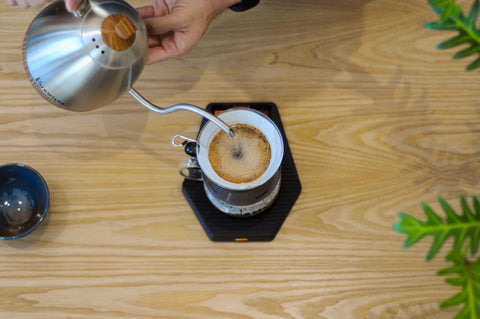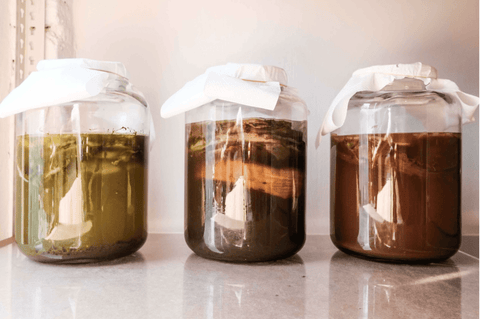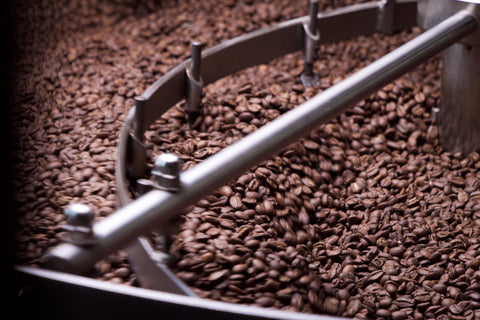
Part Three: The Barista’s Hands
For our third and final piece of the series, we look at how a Barista’s Hands can influence the flavours of coffee by using meticulous techniques as the finishing touches. What is a Barista? In short, it is the talent that brews the perfect blend of coffee for you.
At the core of it, making coffee is simply mixing coffee together with water. When coffee comes in contact with water, the distinct coffee flavour is extracted from the coffee grinds into the water which in turn gives you a cup of joe.
With the basics established, there are many variables in making the perfect cuppa. With so many brewing apparatus to make coffee, the art of brewing it can be confusing. So instead of discussing the different ways of making coffee, let's look at what affects the final outcome: the flavours of coffee.
-----
Water Temperature
When we talk about extraction of the flavour compound present in coffee, heat is one of the few variables that pops up, think of it as a highway that helps to transport the flavour particles of coffee to water.
Using a higher temperature to extract the flavour compounds leads to more body and sweetness, yet bitter and astringent (dry feeling from unripe banana). On the other hand, using lower temperature reduces the chances of bitterness, but it increases the possibility of sourness.
A good rule to follow is to try out temperatures at 90°C to 95°C, but never be afraid to experiment outside of it. For instance, the specialty coffee industry is not stranger to cold brew coffee. To explain, cold brew is a way of making coffee with room temperature (or lower) water, soaking the grinds in it for 8 - 24 hours. By comparing cold brew and hot brew (coffee that is done using 90°C to 95°C ), cold brew tends to taste less acidic and bitter while the latter gives off more acidic and bitter notes.
Essential Tool : Thermometer
-----
Grind Size
The structure of coffee beans is dense and complex, simply pouring water won't properly extract much of the flavour. Thus, grinding is done to break down coffee beans into smaller particles. Using the science behind thermal conductivity, the smaller particles mean there's more surface area for the water to come in contact with. The larger the surface area, the easier for the process of extraction.
Furthermore, the grind size determines how the coffee is going to be brewed, brew methods like the espresso call for a finer grind, whereas a french press requires a coarser grind. Finer grinds extract flavour compounds more easily, compared to coarse grinds, which may cause `over extraction’. This occurs when there are too many flavour compounds extracted, resulting in a bitter cup of coffee. On the other side things, ‘under-extraction’ happens when the grind is coarse, causing a lack of flavour.
How To Identify Grind Sizes and Its Brewing Methods:
Coarse
Outlook & Feel : Noticeable chunky piece, kosher salt
Brewing Method : French Press, Coldbrew and Syphon
Medium
Outlook & Feel : Noticeable flakes, rough sands
Brewing Method : Drip coffee (Kalita Wave etc), Automated drip coffee ( Wilfa, Moccamaster etc)
Fine
Outlook & Feel : Smooth texture, slightly finer than table salt
Brewing Method : Drip coffee ( Hario V60), Moka Pot
Extra Fine
Outlook & Feel : Finer than granular sugar
Brewing Method : Espresso Machine
Turkish
Outlook & Feel : Powdery, flour consistency
Brewing Method : Ibrik
Essential Tool : Grinder
-----
Ratio
When we discuss the ratio, we’re talking about the ratio of coffee to water. In other words, how we determine the perfect balance between coffee and water. Too little coffee may result in diluted cups of coffee, while too much coffee can cause the coffee to taste too overpowering.
Ratio can be subjective, most of time it's personal preference. In the search of the “Golden Ratio”, a good place to start is 1:15. The ratio of 1 to 15 suggests for every 1 gram of coffee, 15 grams of water is needed. As an example, if you're using 20 grams of coffee, 300 gram of water is the optimum amount to balance the overall flavour density. The easiest way to do this is to use a weighing scale to measure the coffee and water.
Apart from that, a good example on how ratio alters the flavour is by comparing a cup of espresso (around 1:2 ratio) and drip coffee ( around 1:15 ratio). When these 2 beverages are put side by side, espresso with a lower difference in coffee to water ratio can be easily distinguished by its strong taste, compared to the filtered drip coffee.
Essential Tool : Scale
-----
Time
We have come to the last variable that impacts the flavour of coffee. The brew time is the duration of coffee immersed in water. Brew time is the bridge between grind size and ratio.
Different brew methods have specific different brew durations. To illustrate, espresso requires 30-40 seconds for a 40-60 ml of coffee, while V60 (Drip coffee) calls for 3-4 minutes for a 240-300 ml of coffee.
Beyond that, grind size plays a huge part in the brew duration as well, it lies in the ability to slow down or accelerate the time for flavour extraction. In terms of taste, this relates back to ‘under-extraction’ and ‘over-extraction’. To reiterate, a shorter brew time may result in under-extracted (weak & sour) tasting coffee whereas over-extracted (strong & bitter) coffee could come from longer brew time.
Essential Tool : Scale with Timer
-----
There you have it, the variables considered in making a good cup of coffee. With the facts laid out, pay close attention to these influences when you make your own as a tiny impact can make a huge difference in flavour. To put your mind at ease, visit your local coffee shop and have a conversation with them, the perfect cuppa you crave for is in good hands at Forest Cloud.
All things must come to an end, and you have reached the end of the article. By now, we hope you have a better understanding of coffee and the different “hands” that play a role in producing the best flavour, from its roots to your cup.





